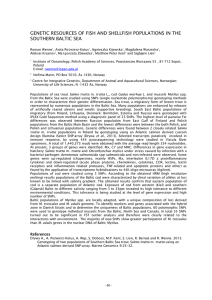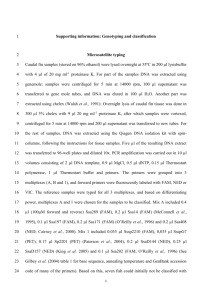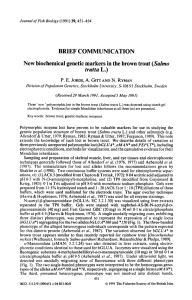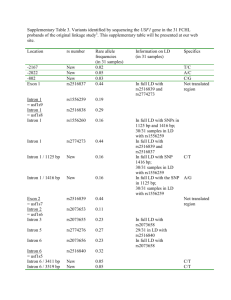Research Journal of Applied Sciences, Engineering and Technology 4(6): 615-620,... ISSN: 2040-7467 ©Maxwell Scientific Organization, 2012
advertisement
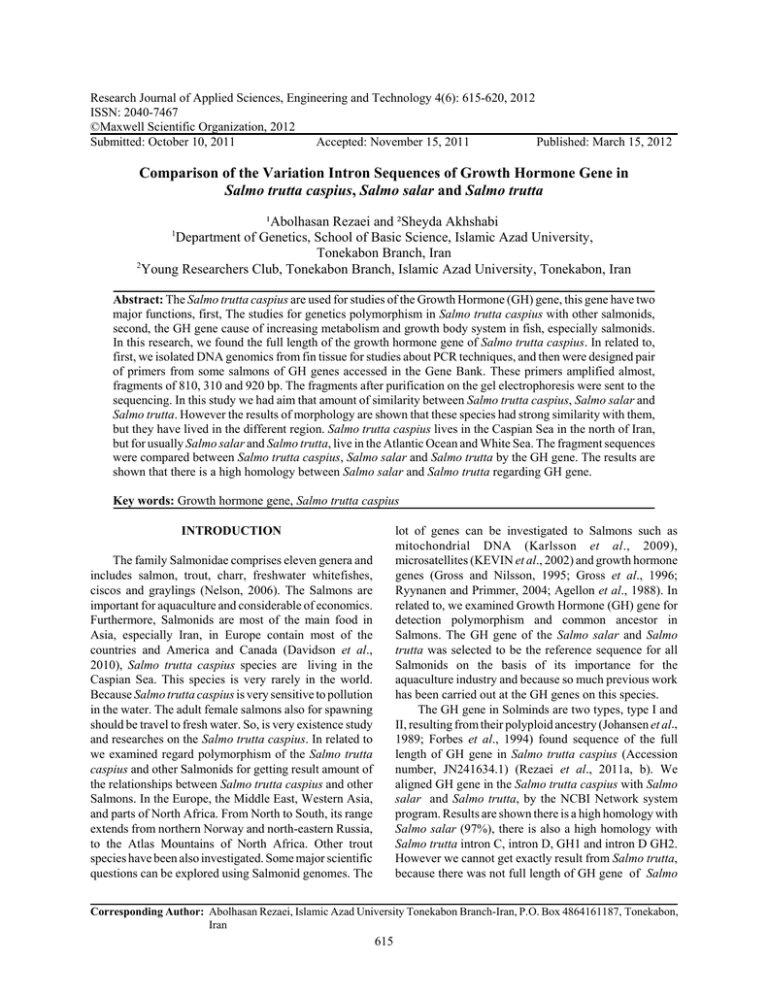
Research Journal of Applied Sciences, Engineering and Technology 4(6): 615-620, 2012 ISSN: 2040-7467 ©Maxwell Scientific Organization, 2012 Submitted: October 10, 2011 Accepted: November 15, 2011 Published: March 15, 2012 Comparison of the Variation Intron Sequences of Growth Hormone Gene in Salmo trutta caspius, Salmo salar and Salmo trutta ¹Abolhasan Rezaei and ²Sheyda Akhshabi Department of Genetics, School of Basic Science, Islamic Azad University, Tonekabon Branch, Iran 2 Young Researchers Club, Tonekabon Branch, Islamic Azad University, Tonekabon, Iran 1 Abstract: The Salmo trutta caspius are used for studies of the Growth Hormone (GH) gene, this gene have two major functions, first, The studies for genetics polymorphism in Salmo trutta caspius with other salmonids, second, the GH gene cause of increasing metabolism and growth body system in fish, especially salmonids. In this research, we found the full length of the growth hormone gene of Salmo trutta caspius. In related to, first, we isolated DNA genomics from fin tissue for studies about PCR techniques, and then were designed pair of primers from some salmons of GH genes accessed in the Gene Bank. These primers amplified almost, fragments of 810, 310 and 920 bp. The fragments after purification on the gel electrophoresis were sent to the sequencing. In this study we had aim that amount of similarity between Salmo trutta caspius, Salmo salar and Salmo trutta. However the results of morphology are shown that these species had strong similarity with them, but they have lived in the different region. Salmo trutta caspius lives in the Caspian Sea in the north of Iran, but for usually Salmo salar and Salmo trutta, live in the Atlantic Ocean and White Sea. The fragment sequences were compared between Salmo trutta caspius, Salmo salar and Salmo trutta by the GH gene. The results are shown that there is a high homology between Salmo salar and Salmo trutta regarding GH gene. Key words: Growth hormone gene, Salmo trutta caspius INTRODUCTION lot of genes can be investigated to Salmons such as mitochondrial DNA (Karlsson et al., 2009), microsatellites (KEVIN et al., 2002) and growth hormone genes (Gross and Nilsson, 1995; Gross et al., 1996; Ryynanen and Primmer, 2004; Agellon et al., 1988). In related to, we examined Growth Hormone (GH) gene for detection polymorphism and common ancestor in Salmons. The GH gene of the Salmo salar and Salmo trutta was selected to be the reference sequence for all Salmonids on the basis of its importance for the aquaculture industry and because so much previous work has been carried out at the GH genes on this species. The GH gene in Solminds are two types, type I and II, resulting from their polyploid ancestry (Johansen et al., 1989; Forbes et al., 1994) found sequence of the full length of GH gene in Salmo trutta caspius (Accession number, JN241634.1) (Rezaei et al., 2011a, b). We aligned GH gene in the Salmo trutta caspius with Salmo salar and Salmo trutta, by the NCBI Network system program. Results are shown there is a high homology with Salmo salar (97%), there is also a high homology with Salmo trutta intron C, intron D, GH1 and intron D GH2. However we cannot get exactly result from Salmo trutta, because there was not full length of GH gene of Salmo The family Salmonidae comprises eleven genera and includes salmon, trout, charr, freshwater whitefishes, ciscos and graylings (Nelson, 2006). The Salmons are important for aquaculture and considerable of economics. Furthermore, Salmonids are most of the main food in Asia, especially Iran, in Europe contain most of the countries and America and Canada (Davidson et al., 2010), Salmo trutta caspius species are living in the Caspian Sea. This species is very rarely in the world. Because Salmo trutta caspius is very sensitive to pollution in the water. The adult female salmons also for spawning should be travel to fresh water. So, is very existence study and researches on the Salmo trutta caspius. In related to we examined regard polymorphism of the Salmo trutta caspius and other Salmonids for getting result amount of the relationships between Salmo trutta caspius and other Salmons. In the Europe, the Middle East, Western Asia, and parts of North Africa. From North to South, its range extends from northern Norway and north-eastern Russia, to the Atlas Mountains of North Africa. Other trout species have been also investigated. Some major scientific questions can be explored using Salmonid genomes. The Corresponding Author: Abolhasan Rezaei, Islamic Azad University Tonekabon Branch-Iran, P.O. Box 4864161187, Tonekabon, Iran 615 Res. J. Appl. Sci. Eng. Technol., 4(6): 615-620, 2012 S.salar GTAAGCCTGCTTTTTCTGTCTATTTCTTTTTTCAGTGGGA S.trutta caspius(intron1)GTAAGCCTGCTTTTTCTGTCTATTTCTTTTTTtAGTGGGA S.trutta (intron d) ........................................ S.trutta (intron C) ........................................ Consensus S.salar AGTCAGTGTACCATTTAGTACAATTTAACTTACACATTTA S.trutta caspius(intron1)AGTCAGTGTACCATTTAGTACAgTTTAACTTACACATTTA S.trutta (intron d) ........................................ S.trutta (intron C) ........................................ Consensus S.salar ATCACTGAGGCAGGGGCCAACACGGCAGAGAAAAGTGAAC S.trutta caspius(intron1)ATCACTGAGGCAGGGGCCAACACGGCAGAGAAAAGTGAAC S.trutta (intron d) ........................................ S.trutta (intron C) ........................................ Consensus S.salar AAGTATTCTACTACTATGAGGTTATAAATCTATTGACACA S.trutta caspius(intron1)AAGTATTCTACTACTATGAGGTTAT.AATCTATTGACACA S.trutta (intron d) ........................................ S.trutta (intron C) ........................................ Consensus S.salar GAACCACCTGCTTTAACAACCTAACTATGTGATCTATAAC S.trutta caspius(intron1)GAACCACCTGCTTTAACAAC CTAACTATGTGATCTATAAC S.trutta (intron d) ........................................ S.trutta (intron C) ........................................ Consensus S.salar ATTTACATTTGAGTCGTTTAGCAGACGCTCTTATCCAGAG S.trutta caspius(intron1)ATTTACATTTGAGTCaTTTAGCAGACaCTCTTATCCAaAG S.trutta (intron d) ........................................ S.trutta (intron C) ........................................ Consensus S.salar CGACTTACAGGAGCAATTAGGGTTAAGTGCCTTGCTCAAG S.trutta caspius(intron1)CGACTTACAGGAGCcATTAGGGTTAAGTGCCTTGCTCAAG S.trutta (intron d) ........................................ S.trutta (intron C) ........................................ Consensus S.salar GGCACGTCGACAGATTTCTCACCTAGTCAGCTCAGGGATT S.trutta caspius(intron1)GGCACaTCGACAGATTTCTCACCTAGTCAGCTCAGGGATT S.trutta (intron d) ........................................ S.trutta (intron C) ........................................ Consensus S.salar GAAACCAGTAACCTTTCAATTACTTACCCAACGCTCTTAA S.trutta caspius(intron1)GAAACCgGTAACCTTTCAATTACTTACCCAACGCTCTTAA S.trutta (intron d) ........................................ S.trutta (intron C) ........................................ S.salar CCGCTAGGCTATTGGTGTTCGATGGCTGAGAATATCTAAC S.trutta caspius(intron1)CCGCTgGGCTATTGGTGTaCaATGGCTGAGAATATCTAAC S.trutta (intron d) ........................................ S.trutta (intron C) ........................................ Consensus S.salar TAATGTATCTCACCATAATTCGACTTACTCGTTTTATACA S.trutta caspius(intron1)TAATGTATCTCACCATAATTCGACTTACTCGTTTTATACA S.trutta (intron d) ........................................ S.trutta (intron C) ........................................ Consensus S.salar TTTGTTATTTTC.....TCTTTCTTTTAG S.trutta caspius(intron1)TTTcTTATTTTatttaaTCTcTCTTTTAG S.trutta (intron d) ............................. S.trutta (intron C) ............................. Consensus 740 40 0 0 780 80 0 0 820 120 0 0 860 159 0 0 900 199 0 0 940 239 0 0 980 279 0 0 1020 319 0 0 1060 359 0 0 1100 399 0 0 1140 439 0 0 1164 468 0 0 Fig. 1: The sequence first intron identity in the GH gene between Salmo trutta caspius, Salmo salar, Salmo trutta intron D and Salmo trutta intron C, was compared by the DNAMAN genetics program. The results are shown that amount of similarity Salmo trutta caspius with Salmo salar is high but there weren’t any similarity with Salmo trutta introns.The underlined sequences are mini and microsatellites in the fragments of Salmo trutta caspius, Salmo salar GH gene 616 Res. J. Appl. Sci. Eng. Technol., 4(6): 615-620, 2012 S.salar CTTTGTAAGACAGCTTTTGAATCTTCTTTTGACATATCAA S.trutta caspius(intron2)....GTAAGACAGCTTTTGAATCTTCTTTTGACATATCAA S.trutta (intron d) ........................................ S.trutta (intron C) ........................................ Consensus S.salar ATAGTGTATCAATGA.TGTTCTTCTTCTTGTAGACAGTGT S.trutta caspius(intron2)ATAaTGTATtAATGAtTGTTCTTCTTCTTGTAGACAGTaT S.trutta (intron d) ........................................ S.trutta (intron C) ........................................ Consensus S.salar CCTCTTTACACAA.CCCTCGTGGCAACAACAAAAAAATCT S.trutta caspius(intron2)CCTCTTTACACAAcCCCTCGcGGCtAaAAaAAAAcAAcag S.trutta (intron d) ........................................ S.trutta (intron C) ........................................ 1438 S.salar CTCTCCCTTCTTTGTGATTT 128 S.trutta caspius(intron2)aaaatCtcTCTc........ S.trutta (intron d) .................... 0 S.trutta (intron C) .................... 0 Consensus 1340 36 0 0 1379 76 0 0 1418 116 0 0 Fig. 2: The sequence second intron identity in the GH gene between Salmo trutta caspius, Salmo salar, Salmo trutta intron d and Salmo trutta intron C, was compared by the DNAMAN program. The results are shown that amount of similarity Salmo trutta caspius with Salmo salar is high but there weren’t any similarity with Salmo trutta introns. The underlined sequences are mini and microsatellites in the fragments of Salmo trutta caspius, Salmo salar GH gene Chrom Taq Assay buffer, 0.5 :L ChromTaq enzyme (3 U/:L), Water 37.5 :L, in a total volume, 50 :L. 94º of 5 min, 35 cycles of 94ºC 30 sec., 55ºC 30 sec. and 72ºC 1 min. Two to ten :L of each PCR reaction were run on 1% agarose gels in TAE buffer containing ethidium bromide. One :L 500 bp, DNA ladder (Gibco-BRL) was used as a size standard. Then the PCR products after purification by the Chromous kit purification were sent to the Choromous Geni Company-India for doing sequence. trutta in the Gene Bank. The objectives of this research, studies of polymorphism between Salmo trutta caspius populations and amount of relationships with Salmo salar and Salmo trutta, moreover, the capability transforming GH gene in Salmons for our future planning. MATERIALS AND METHODS The Salmo trutta caspius used the experiment originated from two rivers in Iran (the river of Dohezar and Sardabroud in the North of Iran). These fishes had been 3 years age old . They were anesthetized with MS2220 and extracted of blood from caudal vein. Blood samples (2-5 mL) were removed from the Wsh via caudal puncture (G.18 needle) using a heparinized syringe (as an anticoagulant for blood sampling) after using MS2220 (1:10,000) as an anesthetic to minimize stress. RESULTS Analysis of the polygenetics of GH gene in the salmo trutta caspius: The primers were designed to four segments of the GH gene, because full length of the GH gene in the Salmo trutta caspius has been around 4700 nucleotides. The fragments contain of the introns. In related to, we compared between of the Salmo trutta caspius GH gene with 33 sequences reporting to the NCBI Network system by DNAMAN gene program. The introns which ranged from 1 to 2541 nucleotides. According to for introns contains: (45.. 512), (653.. 803), (921.. 1063), (1220.. 1473), (1621.. 1844). Process of designing primers: For designing primers we had to use some sequences from Gene Bank, NCBI Network system. In related to, we thought the sequences of Salmo salar GH gene have been high homology with Salmo trutta caspius, because Salmo salar and also other bony fishes have same shape and morphology with salmo trutta caspius, therefore we had risk and was synthesized primers. Also, these sequences were around 4700 nucleotides, so, for getting high performance, we designed primers some part of the full length of GH gene of Salmo salar by the NCBI Network program and DNAMAN genetics program. These primers amplified 330, 850, 910 bp. from first to end of the GH gene of Salmo trutta caspius. The PCR programs: The PCR reaction used 10 microgram PCR reactions contained: 1 :L template DNA, 2 :L forward primer (100 ng/:L), 2 :L reverse primer (100 ng/:L), 2 :L dNTP mix (2.5 mM each), 5 :L 10X Comparison of the GH introns in the salmo trutta caspius with other salmons: In related to, compared between GH introns in the Salmo trutta caspius and other Salmons, including Salmo salar population by the DNA gene program. Therefore the results are shown; there is low homology between in the introns. In the Fig. 1, first intron aligned with Salmo trutta and Salmo salar populations. We observed that there is high homology between Salmo salar. Regarding to the Salmo trutta homology was not significant, in the Fig. 2, second intron compared with Salmons population, which high 617 Res. J. Appl. Sci. Eng. Technol., 4(6): 615-620, 2012 S.salar CAAAGGTTTTTAACTCAATC 2294 S.trutta caspius(intron3) ........TTTggCgggtTg 12 S.trutta (intron C) CAAAGGTTTTTAACTCAATC 730 S.trutta (intron d) .................... 0 Consensus S.salar ATGTAAATAGGGAATCTCAAGCTGTACAATACAACGCAAC S.trutta caspius(intron3) gTGTAAATAGGGAATCTCAAGCTGTACAATACAACGCAAC S.trutta (intron C) ATGTAAATAGGGcATCTCAAGCTGTACAATACAACGCAAC S.trutta (intron d) ........................................ Consensus S.salar TTCATTTTCCAATAATCTGTGGTTTCTCTACATCTACACA S.trutta caspius(intron3) TTCATTTTCCAATAATCTGTGGTTTCTCTACAcacACAg. S.trutta (intron C) TTCATTTTCCAATAATCTGTGGTTTCTCTACAcacACAag S.trutta (intron d) ........................................ Consensus 2334 52 770 0 2374 92 810 0 Fig. 3: The sequence third intron identity in the GH gene between Salmo trutta caspius, Salmo salar, Salmo trutta intron D and Salmo trutta intron C, was compared by the DNAMAN program. The results are shown that amount of similarity Salmo trutta caspius with Salmo salar is high. There is also similarity with Salmo trutta intron C. The underlined sequences are mini and microsatellites in the fragments of Salmo trutta caspius, Salmo salar and Salmo trutta GH gene S.salar CAAGGTAAAGAAAGGAGGGAGAACAATGACCATTTGTGGT S.trutta caspius(intron4) .....TAAAGAAAGGAGGGAGAACAATGACCATTTGTGGT S.trutta (intron d) ....GTAAAGAAAGGAGGGAGAACAATGACCATTTGTGGT S.trutta (intron C) ........................................ Consensus S.salar GCCACACTTTGTGCACTGTAAACCCCAAGGCATTTTTAAC S.trutta caspius(intron4) GCCACACTTTGTGCACTGTAAACCCCAAGGCATTTTTAAC S.trutta (intron d) GCCACACTTTGTGCACTGTAAACCCCAAGGCATTTTTAAC S.trutta (intron C) ........................................ Consensus S.salar TCAAATACTTCTAGTAAGTTGAACTCAAAGTCAATGAAAA S.trutta caspius(intron4) TCAAATACTTCTAGTAAGTTGAAgTtgtg........... S.trutta (intron d) TCAAATACTTCTAGTAAGTTGAACTCAAAGTCAATGAAAA S.trutta (intron C) ........................................ 2574 35 36 810 2614 75 76 810 2654 104 116 810 Fig. 4: The sequence fourth intron identity in the GH gene between Salmo trutta caspius, Salmo salar, Salmo trutta intron D and Salmo trutta intron C, was compared by the DNAMAN program. The results are shown that amount of similarity Salmo trutta caspius with Salmo salar is high. There is also similarity with Salmo trutta intron D. The underlined sequences are mini and microsatellites in the fragments of Salmo trutta caspius, Salmo salar and Salmo trutta GH gene homology with Salmo salar sequences but low homology with sequences of the Salmo trutta. Also we compared third and fourth fragments intron for finding amount of homology between Salmons , that which high homology regarding Salmo salar and Salmo trutta populations (Fig. 3 and 4). Fifth intron also aligned but only there were similarity with Salmo salar. Regarding to Salmo trutta was not observed any homology with Salmo trutta caspius GH gene (Fig. 5). Onchorhynchus mykiss and Salmo trutta. However the information regarding polymorphism of the GH gene in fish is rather scarce (Park et al., 1995). Identified polymorphism in intron D of the GH 1 gene in the Salmo trutta, Salmo trutta intron C (Phillips et al., 2004), Chinook salmon, polymorphism was found also in Pink salmon GH2 intron C (Spruell et al., 1999), intron C of the Coho salmon GH1 gene that is due to a variable number of copies of a 31 nucleotides repeat. (Forbes et al., 1994). Nucleotide and repeat polymorphism in GH introns C and D of Oncorhynchus masou was described by McKay et al. (1998). Differences in the number of repeat monomers also resulted in polymorphism in the third intron of the barramundi GH gene (Yowe and Epping, 1996). Sequence analysis of GH genes from different groups of teleosts have both fundamental and practical significance. It may result in better understanding of GH gene evolution in teleosts and allow for tracing the origin of the fifth intron. Identifying possible allelic variations may also prove useful as DISCUSSION Annotations introns fragment of GH gene in the salmo trutta caspius: The GH gene in the Salmo trutta caspius has 5 introns in the full length. While in the Salmo salar, GH gene also have 5 introns, but the length of introns in the Salmo trutta caspius are shorter than Salmo salar GH gene. The introns had also been strong homology with GH gene in the bony fishes, specially, Salmo salar, 618 Res. J. Appl. Sci. Eng. Technol., 4(6): 615-620, 2012 Consensus S.salar GACATGCACAAGGTGCAAAACCATGTTGCCTTCTATTTCA S.trutta caspius(intron5)............GTGCAAAACCATGTTGCCTTCaATTTCA S.trutta (intron d) ........................................ S.trutta (intron C) ........................................ Consensus S.salar TGTGCCTTCCTATATTTTCTACAGTGCG....TTTCTTGT S.trutta caspius(intron5)TGTaCCTTCCTATATTTTtTACAGTGCGttgtTTTtTTGT S.trutta (intron d) ........................................ S.trutta (intron C) ........................................ Consensus S.salar GCTCTCTATTGCAAAGTATCTTTGGGTCTTTAACCCATAT S.trutta caspius(intron5)GCTCTCTATTGCAAAGTATCTTTGGGTCTTTAACCCATAT S.trutta (intron d) ........................................ S.trutta (intron C) ........................................ Consensus S.salar ATTATTACTATTATTGTTCATTGATCAAGACTGTTCTCGA S.trutta caspius(intron5)ATTATTACTATTATTGTTCATTGATCAAGACTGTTCTCGA S.trutta (intron d) ........................................ S.trutta (intron C) ........................................ Consensus S.salar GAAAGGTCTAGTGACCTAGAACACTCACATTAAAATGTGT S.trutta caspius(intron5)GAAAGGTCTAGTGACCTAGAACACTCACATTAAAATGTGT S.trutta (intron d) ........................................ S.trutta (intron C) ........................................ Consensus S.salar CAACTATAACCCATTCTTCTATTTTTCCCCCAAGGTCGAG S.trutta caspius(intron5)CAACTATAACCCATTCTTCTATTTTTtCCCCccaag.... 224 S.trutta (intron d) ........................................ 1096 S.trutta (intron C) ........................................ 810 Consensus 3829 28 1096 810 3865 68 1096 810 3905 108 1096 810 3945 148 1096 810 3985 188 1096 810 4025 Fig. 5: The sequence fifth intron identity in the GH gene between Salmo trutta caspius, Salmo salar, Salmo trutta intron D and Salmo trutta intron C, was compared by the DNAMAN genetics program. The results are shown that amount of similarity Salmo trutta caspius with Salmo salar is high but there weren’t any similarity with Salmo trutta introns. The underlined sequences are mini and microsatellites in the fragments of Salmo trutta caspius, Salmo salar GH gene genetic markers for commercially important traits, similar to recent findings in domesticated animals. while in Salmo salar region of rich CT is high. On the other hand, the length of second intron GH in Salmo trutta caspius is 128 nucleotides while in the Salmo salar is 136 nuucleotides. However, there is not any homology between Salmo trutta caspius second intron with Salmo trutta intron D and C. The length of the sequences aligned by DNAMAN program genetics, results are shown that there is minor variation between Salmo trutta caspius and Salmo salar, but the length of the Salmo salar is more than Salmo trutta caspius length of second intron GH. First intron: The first intron sequence ranged from nucleotide of 45 to 512, and alignment was 377 bp. The analysis of first GH intron between Salmo trutta caspius and Salmo salar, has been strong homology but there is not any homology with Salmo trutta. These results are shown that the full length of intron D in the Salmo trutta was not district the GH gene in the Salmo trutta caspius and also Salmo salar. Many mini- and microsatellite repeat sequences were found throughout the noncoding region of the length of first intron which results in extensive allelism due to different numbers or length of repeats. That which includes, repeats (CTTTT..). Interestingly , the three nucleotide and tetra nucleotide tandem repeat (ATT and ATTT)n found in the first intron of Salmo salar GH gene is similar to the three and tetramer tandem repeat (ATT) in the first intron of Salmo trutta caspius GH gene. Third, fourth and fifth fragments intron: The extensive polymorphism in the third, fourth and fifth fragment, were found a lot mini and microsatellites in the different regions of the fragments which has potential to serve as genetic markers in genetic selection for desirable traits in the Salmons GH gene. In the third intron of Salmo trutta caspius ranged of 92 nucleotides but in the Salmo salar and Salmo trutta intron C were 100 nucleotides, regarding Salmo trutta intron D there weren’t any nucleotides in span of that nucleotides. The sequences also were aligned by DNAMAN genetics program there are high homology between sequences, however length of the Salmo trutta caspius was shorter than other two sequences. In the other feature, there are region of the rich AT and TC in the length of sequences. The fourth intron GH aligned also by the DNAMAN program, results are shown that strong Second intron: In the second intron sequences is that it contains in its sequence the three and tetranucleotides repeat, CTT and CTTT which are in the length of second intron in Salmo salar and also Salmo trutta caspius. Another interesting feature of this region of rich A nucleotides in the end of length Salmo trutta caspius 619 Res. J. Appl. Sci. Eng. Technol., 4(6): 615-620, 2012 homology between Salmo trutta caspius and Salmo salar however is shorter than Salmo trutta caspius regarding fourth intron GH. The results also are shown that there are mini and microsatellites, specially nucleotides rich of AAT and TAA in the fourth and fifth intron. In related to, intron C had high homology with Salmo trutta caspius and Salmo salar, but the length of the fourth intron in Salmo trutta caspius was shorter than intron C and Salmo salar length. Regarding to the fifth intron there were also strong homology with Salmo salar but there weren’t any homology with Salmo trutta intron D and C. Karlsson, S., T. Moen and K. Hindar, 2009. An extended panel of single nucleotide polymorphisms in Atlantic salmon (Salmo salar L.) mitochondrial DNA. Con. Gen., 2: 11: 123-149. Kevin, S., J.F. Williamson., F. Cordes and M. Bernie, 2002. Characterization of microsatellite loci in chinook salmon (Oncorhynchus tshawytscha) and cross-species amplification in other salmonids, Mol. Eco. N., 2: 17-19. McKay, S.J., I. Nakayama, M.J. Smith and R.H. Devlin, 1998. Genetic relationship between masu and amago salmon examined through sequence analysis of nuclear and mitochondrial DNA. Zool. Sci., 15: 971-979. Nelson, J.S., 2006. Fishes of the World. 3rd Edn., Wiley and Son, New York. Park, L.K., P. Moran and D.A. Dightman, 1995. A polymorphism in intron D of the chinook salmon growth hormone 2 gene. Anim. Genet., 26: 285. Phillips, R.B., M.P. Matsuoka, N.R. Konkol and S. McKay, 2004. Molecular systematics and evolution of the growth hormone Introns in the Salmoninae. J. Environ. Biol. Fishes., 69: 433-440. Rezaei, A., S.H. Akhshabi and H.R. Jamalzadeh, 2011a. investigation and identification salmo trutta caspius by the growth hormone type 1 (GH1) gene analogue. B. J. Biotech., 3: 76-82. Rezaei, A., S.H. Akhshabi and H.R. Jamalzadeh, 2011b. Sequencing and sequence analysis of growth hormone type 1 (GH1) gene homologue in the salmo trutta caspius. Adv. S. Biol., 3: pp. Ryynanen, H.J. and C.R. Primmer, 2004. Primers for sequence characterization and polymorphism detection in the Atlantic salmon (Salmo salar) growth hormone 1 (GH1) gene. Mol. Eco. Not, 4: 664-667. Spruell, P., K.L. Pilgrim, B.A. Greene, C. Habicht, K.L. Knudsen, K.R. Lindner, J.B. Olsen, G.K. Sage, J.E. Seeb and F.W. Allendorf, 1999. Inheritance of nuclear DNA markers in gynogenetic haploid pink salmon. J. Hered., 90: 289-296. Yowe, D.L. and R.J. Epping, 1996. A minisatellite polymorphism in intron III of the barramundi (Lates calcarifer) growth hormone gene. Genom., 39: 934-940. ACKNOWLEDGMENT This study had financially supported by the research council of Islamic Azad University Tonekabon branch. REFERENCES Agellon, L.B., S.L. Davies, C.M. Lin, T.T. Chen and D.A. Powers, 1988. Rainbow trout has two genes for growth hormone. Mol. Reprod. Dev. M., 1: 11-17. Davidson, S., F. William, J.M. Ben, J. Koop, I. Steven, V. Patricia, M. Rodrigo, I. Alejandro, L. Jonassen, L. Sigbjorn and W.O. Stig Omhol, 2010. Sequencing the genome of the Atlantic salmon (Salmo salar). Gen. Bio., 11: 403. Forbes, S.H., K.L. Knudsen, T.W. North and F.W. Allendorf, 1994. One of two growth hormone genes in coho salmon is sex-linked. Proc. Natl. Acad. Sci. U.S.A., 91: 1628-1631. Gross, R. and J. Nilsson, 1995. Application of heteroduplex analysis for detecting variation within the growth hormone 2 gene in (Salmo trutta L.) brown trout. Hered., 74: 286-295. Gross, R., P. Schlee, H. Stein and O. Rottmann, 1996. Detection of allelic variation within the growth hormone gene in common bream using heteroduplex analysis. J. Fish Biol., 48: 300-310. Johansen, B., O.C. Johansen and S. Valla, 1989. The complete nucleotide sequence of the growth hormone gene from Atlantic salmon (Salmo salar). Gen., 77: 317-324. 620

